Finally, a home for Paynter’s paintings
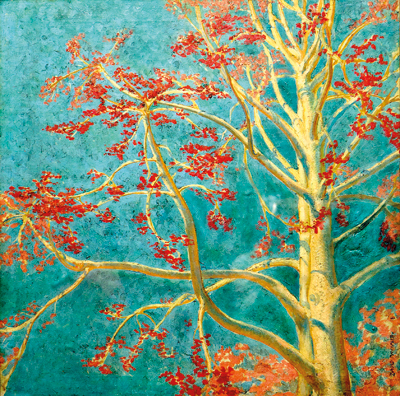
Blooming cotton tree - 1950
Nineteen paintings of one of Sri Lanka’s most distinguished artists David Shillingford Paynter have finally found a fitting home in a permanent gallery at the J.D.A.Perera Gallery at the Faculty of Visual Arts of the University of Visual and Performing Arts in Colombo. The journey of the paintings from the home of the late artist in Nuwara Eliya to the permanent gallery in Horton Place, Colombo, has taken many years and has been marred by controversy.
David Paynter who is best known for his celebrated murals at the Chapel at Trinity College, Kandy, passed away in June 1975 and after his demise, the custody of all his paintings went to his sister Evangeline Darling. It was by way of her last will that the 19 paintings were selected to be placed in a permanent gallery. She had decided so in 1990 but it was only on March 5, this year that her last wish came true and the doors of the David Paynter Gallery opened to the public.

Paynter’s work on the first floor of the JDA Perera building. Pix by Sameera Weerasekera
The story of the journey of the paintings to its present location is an attention-grabbing one with a chance meeting between a student who was studying at the Faculty in 2015 and its present Vice Chancellor, Professor Sarath Chandrajeewa, then Dean of the Faculty, leading to the unravelling of the whereabouts of these paintings.
“I had no idea that 19 paintings had been gifted to the Faculty by way of the last will of David Paynter’s sister but it was brought to my notice by a student who was studying at the Faculty when I was the Dean there. Her family had been closely acquainted with the Paynters and on a visit to the Paynter Home in Nuwara Eliya she had found out that the paintings that were gifted to be kept in a permanent gallery had gone missing,” Professor Chandrajeewa said.
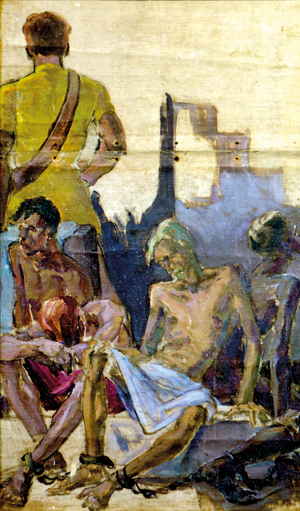
Chained men. Date unknown
This prompted him to contact the Managing Director and Trustee of the Paynter Home who in turn lodged a written complaint about the lost paintings setting in motion a series of events which finally led to the recovery of all the paintings.
The Faculty of Visual Arts had always held a special place in the heart of David Paynter. In his time it was called the Government College of Arts and Crafts and housed at the Heywood Building. David Paynter served as its
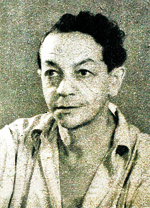
David Paynter
Principal from 1960-63. Hence it seemed the natural choice of his sister to gift several of his paintings to the Faculty.
“After David Paynter’s demise, all his paintings were entrusted to the custody of his sister and they were kept at the Paynter Home in Nuwara Eliya. She had chosen 19 of these to be gifted to the Faculty where her brother once served as principal,” Prof. Chandrajeewa said.
To facilitate the process of transferring the paintings, Ms. Darling had appointed a three member committee comprising Professor A.J. Gunawardene, Professor Senaka Bandaranayake (both now deceased) and Professor Albert Dharmasiri, who was the representative of Ms. Darling and the Chairman of the Committee. Prof.Dharmasiri had taken over the paintings in October 2010 but they had not reached the Faculty of Visual Arts. Relatives of Paynter had made several inquiries about the whereabouts of the paintings from Faculty administrators only to be told that they were not in
possession of any such paintings.
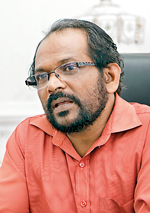
Dean of the Faculty of Arts Prof. Ramyawardana Podinilame
It was five years later when Professor Chandrajeeewa took over as the Dean of the Faculty that details regarding the missing paintings began to surface. Initially he had investigated the complaint at the University level and
after failing to get the paintings back, lodged a complaint with the Financial Crimes Investigation Department (FCID) of the Police. “The FCID carried out an investigation and traced the paintings and they were finally handed over to the Faculty on November 19, 2015,” Professor Chandrajeeewa said.
After the recovery of the paintings, it fell on Prof. Ramyawardana Podinilame, the current Dean of the Faculty of Arts at the University of Visual and Performing Arts to oversee the setting up of the David Paynter Gallery.
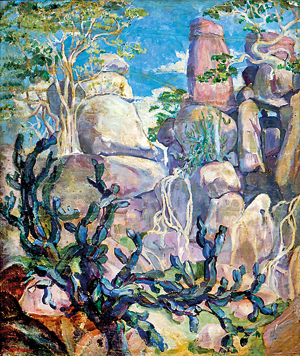
Andhan Kulam Rocks. Date unknown
“Several of the paintings had been kept in poor storage and some of the canvases were damaged with holes in them. My immediate task was to get them cleaned up and framed,” Prof. Podinilame said.
These paintings, all oils on canvas, include landscapes, a self-portrait and several Christian religious scenes including two figurative paintings depicting the washing of the disciples’ feet by Jesus Christ.
The paintings are now exhibited at the J.D.A.Perera Gallery at Horton Place but as the first permanent gallery dedicated to a single Sri Lankan artist, it is still in its infancy with much more to be done to educate visitors on the life of David Paynter and his great works.
“We are in the process of gathering information on David Paynter’s life as well as all his work so that visitors and particularly schoolchildren will be able to learn about the life of this great Sri Lankan artist, Prof. Podinilame said.
In the catalogue available at the Gallery, Prof. Chandrajeewa notes: “He had been a great asset for all the younger generations after him. After he resigned from the Government College of Art, he bought a land in Trincomalee and did farming to raise money for the orphaned children of the Paynter Home.”
The David Paynter Gallery is at the J.D.A.Perera Gallery at Horton Place, Colombo 7 and open to the public every weekday from 9 a.m. to 5 p.m.
| ‘Sinhalisation ‘of Christ’s scenes | |
 Study for washing of the feet of disciples - 1924 David Paynter was born on March 5,1900 in Uttar Pradesh in North India to missionary parents, Arthur Paynter (British) and Agnes Weerasooriya and educated at Breeks Memorial School, a school for the children of missionaries in South India and at Trinity College , Kandy. After volunteering in the first World War as a 16-year-old, at the age of 19 he won a five year scholarship to study at the Royal Academy of Art, Britain’s oldest art school and won the Gold Medal there. There on he won the Scott Travelling Scholarship for two years study in Italy. An Indian art critic writing in the Illustrated Weekly of India in 1952 said that while in England, Paynter was influenced by the post impressionists and the cubists while in Italy he found in the work of Italian primitives (pre Renaissance artists) much that was valuable. Most Sri Lankans remember Paynter best for his murals at Trinity College in Kandy depicting several scenes from the life of Jesus Christ including the Crucifixion. “It was about 1930 that the Principal of Trinity College , the Rev. A.G. Frazer and the Vice Principal Mr. Gaster decided to have a chapel built in the Kandyan style, “a building in the vernacular”, as it was decided. The idea was that even if it be a place of worship for Christians, the building should be in harmony with the surroundings. This seemed in those days a revolutionary idea. David Paynter, fresh from the West, fitted into the scheme as the muralist for the Chapel,” the Indian writer noted. In an article written by Sujatha Kuruwita, librarian of Trinity College Kandy, and available on the College’s official website, the writer quotes the words David Paynter used to describe his work on the chapel in an interview given over Radio Ceylon at the time. “Having studied art for some time in Italy and France, I found that the painters there had painted their own countries and their own times. So I decided to paint in the way I did, with more or less Ceylon landscapes and more or less Ceylonese types. Besides, I intensely disliked many of the paintings of comparatively recent times where Christ has been portrayed as a blond Englishman and wearing Arab costume….,” he had said. The “Sinhalisation’ of the paintings depicting the life of Jesus Christ provoked controversy at the time but today his paintings are considered the finest among church paintings in the country and the work of a genius who was way ahead of his time. David Paynter died of a heart attack on June 7, 1975 and was buried in the Union Church cemetery in Nuwara Eliya. |


